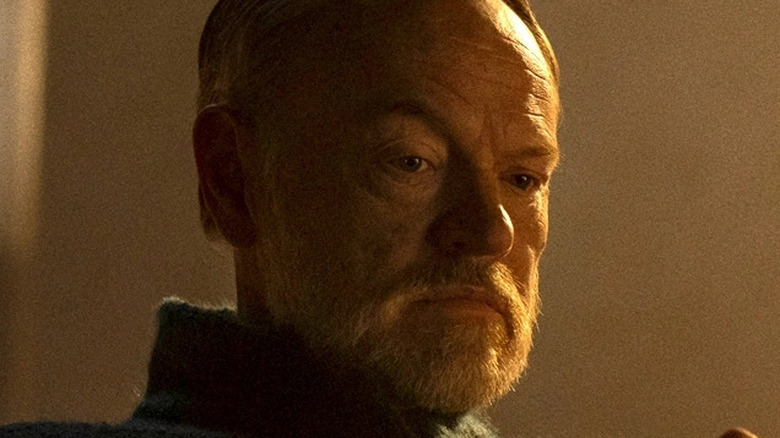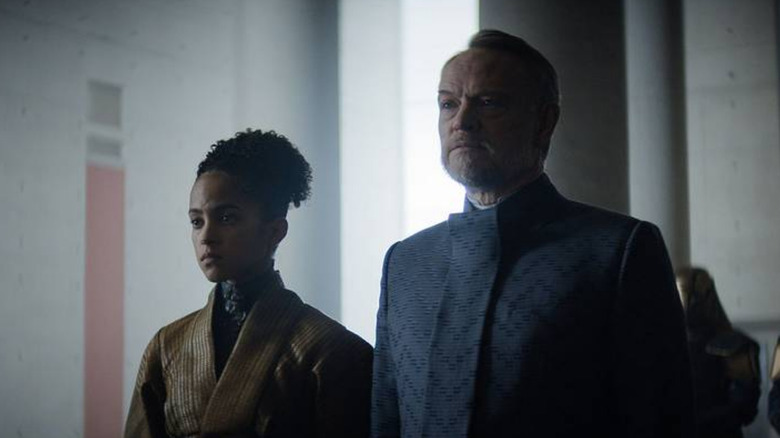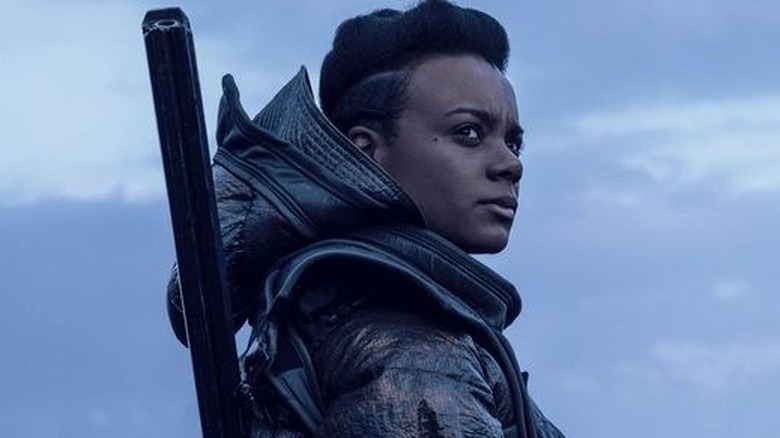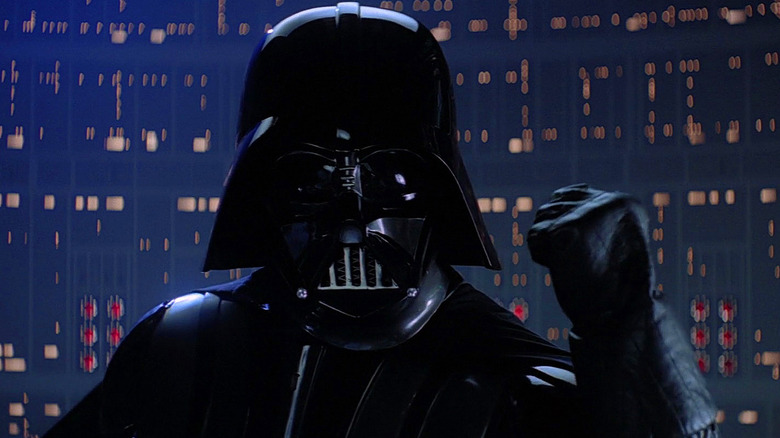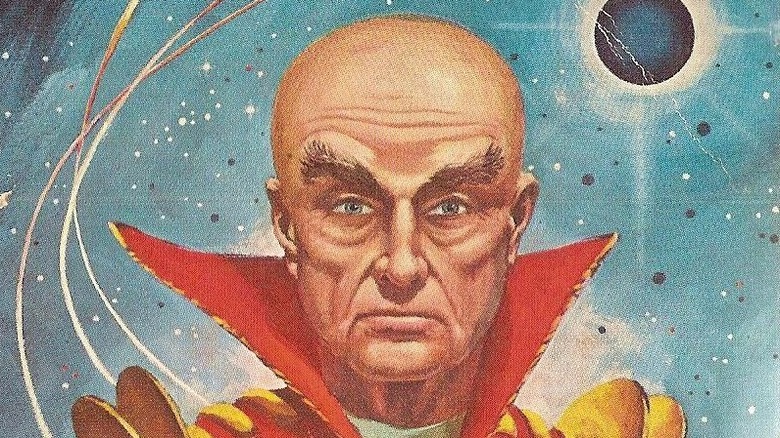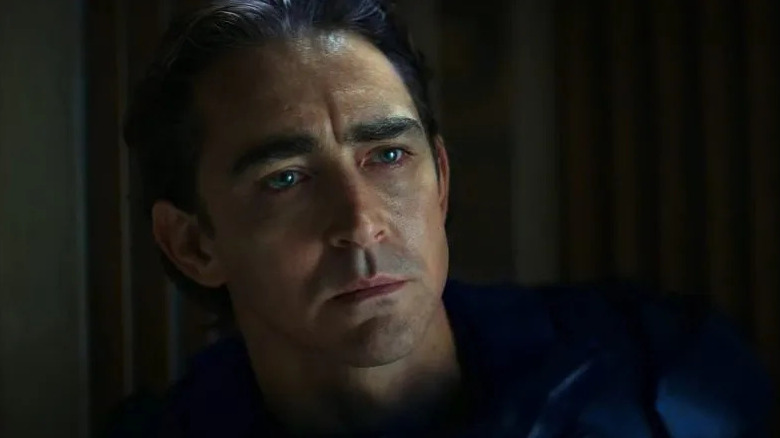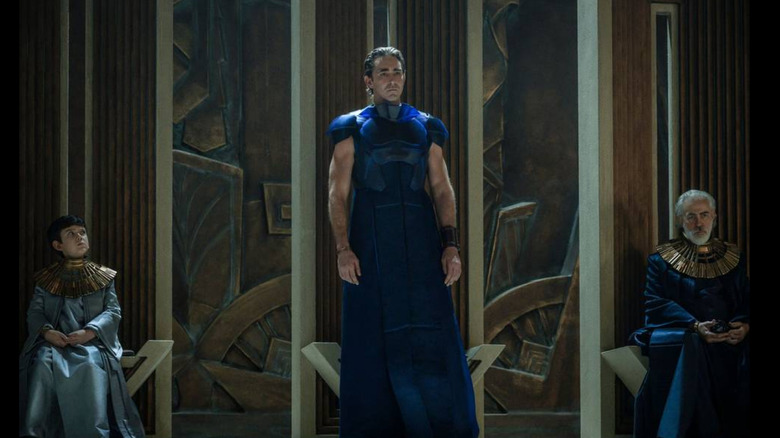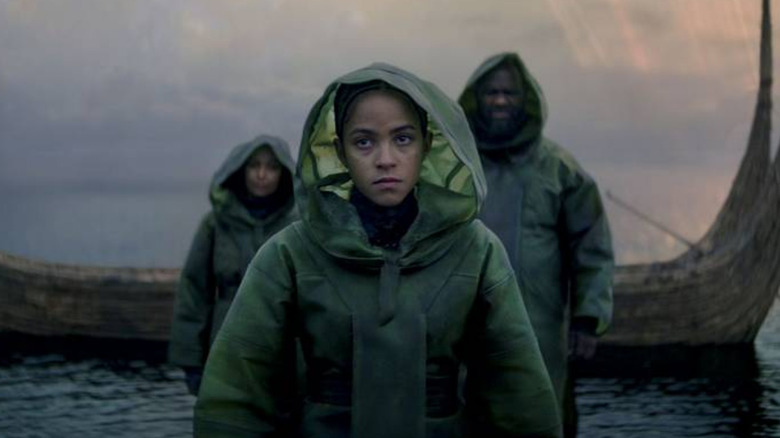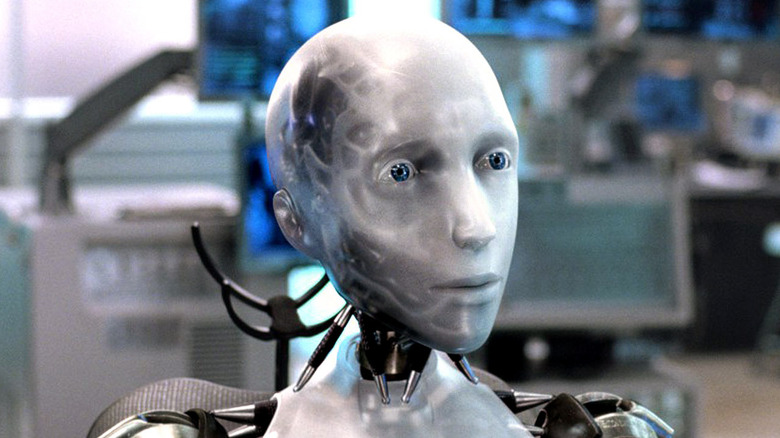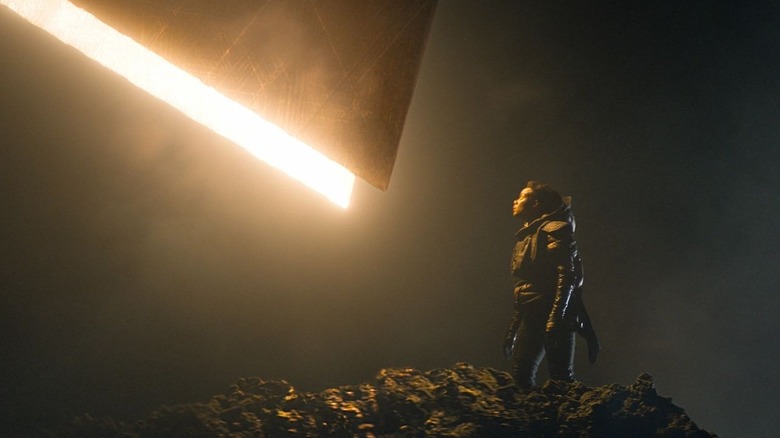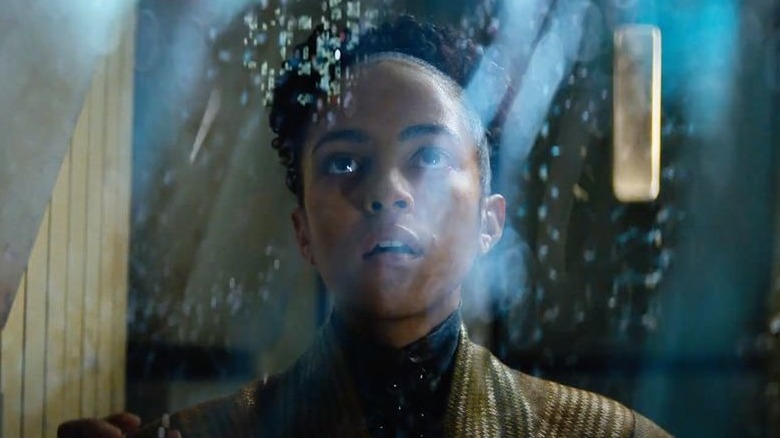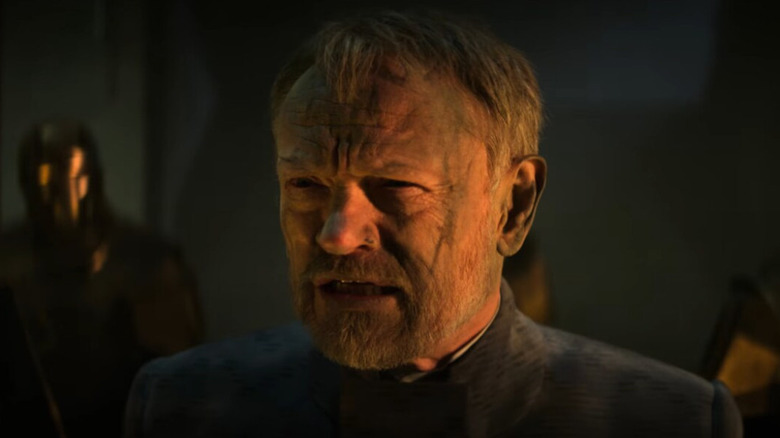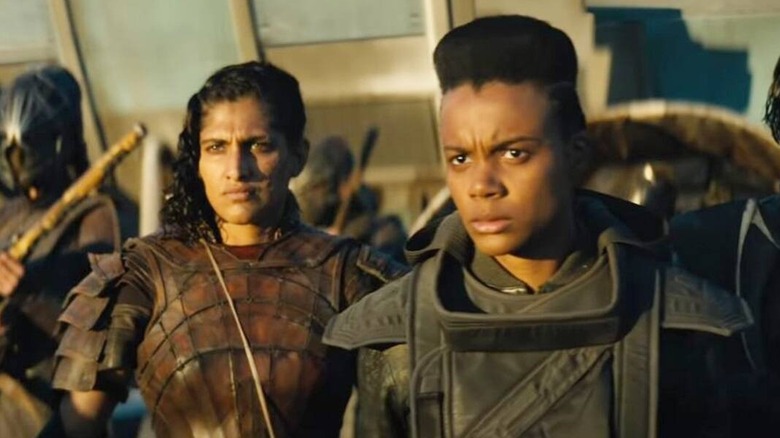The Untold Truth Of Foundation
We are now in a new age of "sumptuous" science fiction and fantasy: highly polished prestige sagas that are expansive in scope, span thousands of years, with vast empires that stretch across the cosmos, populated by larger than life characters belonging to feudal houses, noble castes, and powerful kingdoms.
It all started with "Star Wars," about an interstellar empire and the upstart rebellion that fights them. As studios sought to capitalize on multi-movie sagas, the "Star Wars" prequels led to "The Lord Of the Rings," which in turn gave us the eight-film "Harry Potter" series about a hidden world of magic. As budgets got bigger, "Game of Thrones" arrived on television with its high fantasy world of warring empires. Now we are in a third age, featuring Denis Villenueve's film version of "Dune," the upcoming "Lord Of The Rings" prequel series, and "The Wheel Of Time" fantasy saga, the latter two series both on Amazon. Even Marvel's "Eternals," the story of a race of immortal beings fighting a ceaseless battle against another species, taps into this narrative vein.
"Foundation" on Apple TV+ fits firmly into this category. Based on the series of ambitious, Hugo-Award winning novels by science fiction luminary Isaac Asimov, "Foundation" is the thousand-year story of a Galactic Empire's downfall and evolution, starring Jared Harris, Lee Pace, Leah Harvey, Laura Birn, and Terrence Mann. But with a history of over a dozen books that stretches back over 80 real world years, where do newcomers to the series begin to get acquainted? We've got a few choice nuggets to get you started.
Foundation has been called unfilmable
"Foundation" chronicles a sprawling interstellar empire that stretches across the entire galaxy, and a scientist named Hari Seldon who — using a new form of mathematics of his own design — predicts its downfall and devises a way to save it from extinction. There has long been talk of adapting the books into a film, a movie trilogy, or a TV series before, including attempts by Roland Emmerich ("Independence Day") and Jonathan Nolan ("Westworld") but time and time again the series was deemed "unfilmable."
It's understandable why some critics have included the series in the list of hard-to-adapt books: the early novels on which the show are based are written unconventionally, focusing more on the empire itself and The Foundation — the group created to save the galaxy — rather than any cast of particular characters that grow and change over the course of a specific story. The books are more like a fictional future history lesson, with much of the action happening in between chapters. In fact, the central figure in the story, Seldon, mostly only appears via pre-recorded messages.
Already online user reviews by some "Foundation" diehards have pointed out these changes. But changes or not, some critics have praised the new Apple+ series for its ambitious storytelling and lavish visuals.
The Roman Empire and chemistry inspired Foundation
"Foundation" author Isaac Asimov had a well-chronicled passion for history, and the Roman Empire in particular, even writing his own non-fiction book on the subject. After reading "The Rise And Fall Of The Roman Empire" by Edward Gibbon while attending Columbia University in the 1940s, Asimov was inspired to write his own version, but on the much larger scale of an entire galaxy. There are many obvious comparisons, from the political structure, to the boundless colonies and territories ruled by a single Emperor who struggles to exert control, to the caste-like social system of the empire itself.
This inspiration is often discussed, but what is sometimes overlooked is how "Foundation" was also inspired by the laws of chemistry and the study of molecules and gases. At the time of conceiving the earliest "Foundation" stories, Asimov was also learning chemistry and discovering how one could predict the behavior of gas molecules with incredible accuracy. Supposing that the billions upon billions of people who would make up such a sprawling imperial civilization would be not unlike the billions of gas molecules he was learning about in school, he devised "psychohistory." Set against the backdrop of a vast galactic empire, "psychohistory" was the mathematical discipline that predicted its downfall, and the concept at the heart of Hari Seldon's theories that drove the story of "Foundation."
It inspired Star Wars and Dune
When "Foundation" beat out "The Lord Of The Rings" for a Hugo Award in 1966 for Best All-Time Series, little did Isaac Asimov know it would be just the first of several future classic franchises his series would become connected to.
Decades after publishing his acclaimed novels, a flurry of sci-fi epics hit the shelves and screen, from "Star Wars" and "Dune" to "Hitchhikers Guide To The Galaxy" (which itself is a nod to the "Encyclopedia Galactica" that is featured in "Foundation"). It's not hard to spot the many influences and similarities, most notably the presence of a galactic empire, a concept that was new to the genre at the time.
Asimov believed strongly that other works and their creators, like George Lucas and Frank Herbert, were heavily inspired by his groundbreaking book series, saying, "If you see these pictures, 'Star Wars' and its sequels, there's a certain amount of stuff that came from my 'Foundation' books. But what the heck, a certain amount of my 'Foundation' books came from Gibbon's 'Decline and Fall of the Roman Empire.' So how far back do you want to go? That's the way things work."
It came from the magazine rack
Pulp science fiction magazines such as "Startling Stories" and "Galaxy Science Fiction" were often the first place that science fiction authors — veteran and newcomer alike — took their new stories. Whether a novella, a short story, or a serialized book, many of the genre's greatest authors got their start from those humble beginnings. The first book in Philip Jose Farmer's celebrated "Riverworld" series was first serialized in "Amazing Wonder Stories" while "Blade Runner" creator Philip K. Dick made his first story sale to "Planet Stories."
Likewise, Asimov's original trilogy of "Foundation" novels, the first published in 1951, were actually a collection of eight different short stories that he had written more than a decade before, originally seeing print in the pages of "Astounding Magazine." Asimov, according to his book "The Early Asimov: Or, Eleven Years of Trying," says he came up with the ideas for "Foundation" while working with his favorite editor and mentor, John W. Campbell, a man with what seemed like an impossibly high standard for his writers and who was ruthless with rejections. Through some of his early short stories, like "The Black Friar And The Flame" and "The Imaginary," Asimov would work out the ideas that he would use to form the basis for "Foundation," including the concept of a galactic empire, and the fictional study of "psychohistory." His first "Foundation" stories would later see print in issues published between May 1942 and January 1950.
It was a UK radio drama
While Hollywood has been trying and failing to make an adaptation of "Foundation" for a good long while, most people might not know that it was already once adapted for radio. The first three "Foundation" books published in the 1950s formed a trilogy that for decades amounted to the whole sum of the series. Nobody at the time — likely not even the author himself — knew that the series would continue with four more books in the 1980s and '90s (two sequels and two prequels), as well as a dozen more by other authors.
It was during the limbo period between the third book's printing in 1953 and the first sequel, "Foundation's Edge," in 1981 that the first adaptation of "Foundation" came in the form of a British audio play. The series aired on BBC Radio 4 and dramatized what was then the entirety of the saga: "Foundation," "Foundation And Empire" and "Second Foundation." The serialized radio play covered the entire original trilogy in eight episodes. Even though not all radio dramas from the BBC are readily obtainable, this one has been made available for streaming on Spotify and Apple Music for online listening (and downloading if you have a subscription). They have an authentically vintage, classic pulp sci-fi sound, and even at nearly eight hours long are a must listen for diehard fans of "Foundation."
Apple bought the series after a one sentence pitch
For a show creator, convincing a network to buy your pilot — let alone giving your series a full season order — is a monumental undertaking. They will often arrive at a meeting with Hollywood big-wigs armed with a series bible and ready to answer tough questions about their proposal. Some creators will even develop binders full of concept art to wow the studio heads, and still others will create sizzle reels using crude effects, still images, or voiceovers.
But that was not the case for "Foundation" series creator and filmmaker David S. Goyer (who co-wrote the scripts or stories for all three of Christopher Nolan's acclaimed "The Dark Knight" trilogy). He received a green light from Apple TV+ for his "Foundation" series with just a single sentence description of the premise. Even if it's not the usual way a show gets bought by a studio, it was at Apple's request that he try to give his pitch in one concise line. Speaking to The Hollywood Reporter, Goyer said, "They sort of asked it laughingly. I said: 'It's a 1,000-year chess game between Hari Seldon and the Empire, and all the characters in between are the pawns, but some of the pawns over the course of this saga end up becoming kings and queens.'"
The story of "Foundation" is often described as overly complex, but not everything has to be complicated.
The series will chronicle 1,000 years... and change the books
As Goyer described to Apple studio execs in his pitch meeting, the story of his "Foundation" series will span over 1,000 years, similar to the novels on which they are based. How exactly he'll accomplish that remains to be seen. In the books, the story jumps forward in time repeatedly, introducing new characters and new settings each time. The fates of countless star systems flip back and forth as the lives of billions change with each chapter.
Goyer told the Hollywood Reporter that he has "figured out a way to have some of the characters ... continue from season to season, from century to century. That way it becomes a half anthological, half continuing story." This would obviously be a major break from the original source material, which rarely followed characters over long stretches. Goyer justified the decision, saying "the books aren't particularly emotional and, in general with television, people watch for emotion. They want to fall in love with these characters. So I had to figure out ways of using Asimov's themes and ideas, but internalizing them into the characters." The series has assembled an incredible international cast, so it will be interesting to see if he can pull off translating a series with such big ideas from page to screen.
It's part of the I, Robot universe
Isaac Asimov had two popular but separate book series: "Foundation" and "I, Robot." The "Robot" series, as it is more properly called ("I, Robot" was simply the name of one collection of stories), encompasses six full novels and more than three dozen short stories. A number of these stories have been adapted to the screen: several BBC shows in the UK used "Robot" stories as the basis for episodes, including "Out Of This World," "Story Parade" and "Out Of The Unknown." A 1988 television movie simply called "Robots" adapted plot points from Asimov's books, while the 1999 Robin Williams movie "Bicentennial Man" was based on a novella from 1976. Of course the most notable was the film "I, Robot" starring Will Smith in 2004, which was an original screenplay loosely based on the ideas and concepts featured in Asimov's "Robots" universe.
Asimov later merged his "Robots" book series into the world of "Foundation" novels, with some characters from previous "Robot" stories appearing in "Foundation" sequels. The final book in the "Foundation" saga, "Robots And Empire," firmly integrated the two different series together, as Asimov explained the fate of Earth and how the original worlds came to form the galactic empire. Could the success of "Foundation" lead Apple TV+ to reboot "I, Robot" and tie it into "Foundation" to create the Isaac Asimov Cinematic Universe (ICU)? Only time will tell.
Foundation's design was influenced by Apple
There are a lot of new sci-fi shows on the air these days, from "Star Trek: Discovery" to "Westworld," and even more movies like the latest adaptation of "Dune," so it can be hard for show creators to find a visual style that is truly unique and fresh for their projects. "Foundation" had the benefit of some beautiful and astounding book cover artwork produced over the years to help guide them, but one series concept artist says he found inspiration for the Apple TV+ series in an ironic place.
Perhaps in a meta way of art imitating life, it was some of Apple's own visual aesthetic — with the clean lines and smooth shapes of their computers, tablets, and phones — that influenced some of the concept art created for the new series' environments, ships, and technology. Concept artist Stephan Martinière shared some of his designs for "Foundation" with Creative Bloq, and spoke to them about how the designs for the starships and massive sets were devised. "As more and more sci-fi films are being made and creating a unique visual signature becomes harder ... there are still plenty of interesting visual ideas to come up with unique visuals," he said. "One of them being proposed was to use the Apple sleek design and try to carry it in some of the ship looks."
Foundation used practical sets and locations
Computer generated special effects have come a long way, even in just the short time since Roland Emmerich attempted to turn the "Foundation" novels into a feature film in 2012. Motion capture technology used in the most recent "Planet Of the Apes" trilogy has reached astonishing levels of realism, and The Volume augmented reality walls used on "The Mandalorian" are reshaping how sci-fi epics are made. With all of this incredible technology available, one might assume that "Foundation," set eons in the future and spanning thousands of years across countless alien worlds, would be made up of entirely CGI environments.
Not so, says David S. Goyer, who explained to Decider that the studio invested in the creation of practical sets, and filmed much of the first season on location. "I wanted the show to feel different than a lot of the shows that were being filmed today," he said. Location shooting took place in Tenerife in the Canary Islands, Malta, Iceland, Ireland, and Berlin. Goyer said each alien world was represented in the series by an entirely different location on Earth: "I wanted the show to feel very real."
Actor Lee Pace commented on how the real sets and locations helped his performance, saying, "Speaking as someone who's spent a lot of time in front of blue screens, it was incredible to be able to shoot a character that is big like this character in real locations."
Jared Harris loves Foundation, but hates his performance
Hollywood actors can often be the hardest critics of their own performances, with some even refusing to watch the very movies they star in. "Foundation" actor Jared Harris, who plays the series' central figure, mathematician Hari Seldon, is no stranger to that phenomenon, and has been open about not enjoying the scenes he's appeared in. Nevertheless, he is relishing the experience of being on the show and expressed his amazement about the actors around him. Harris said he has been inspired by the likes of Lee Pace, Leah Harvey, and Llou Lobdell, and the dedication to the craft he sees in his talented co-stars.
"I can't stand the scenes I'm in, but I love watching everybody else," Harris told the Sky News Podcast. "I'm really, really, really impressed with the work, the performances that everybody has been putting in." Impressed as he is, it's perhaps unlikely that he will watch the series even as Deadline recently reported that it will receive a second season: "Personally, it takes me a decade to be able to watch something that I've done and be happy with it." If the series runs as long as creator David S. Goyer hopes, Harris won't be able to watch it for quite some time. Which leads us right into our final untold truth...
It could run for eight seasons
With a second season already announced, we know that the story of "Foundation" will continue. While speaking to Slashfilm ahead of the series premiere on September 24th, David Goyer revealed that he has already given the studio a "loose plan" for the future of the series. Goyer is ambitious, hoping to produce as many as eight full seasons, which — if the first season of the show is any indication — would mean at least 80 episodes. But he doesn't want viewers to think he has no idea what he's doing.
"When I presented the plan for Season 1, Apple knew that it was a big undertaking," Goyer told Slashfilm, "And they wanted at least some inkling that I had a direction of where I was going in future seasons. So I did present a loose plan for eight seasons." Some plot threads in Season 1, he revealed, will not be immediately resolved and will continue into the second season, but made sure to stress that "we know what we're writing towards. We're not just starting from scratch. There is a roadmap."
Working from the seven original books by Isaac Asimov, with more than a dozen related books and stories from other authors, having enough ideas for 80 episodes shouldn't be too difficult. Making it work successfully for eight years would be a challenge for any filmmaker, but Goyer believes he's up to the task.
